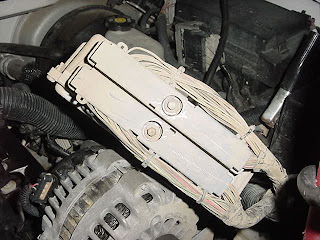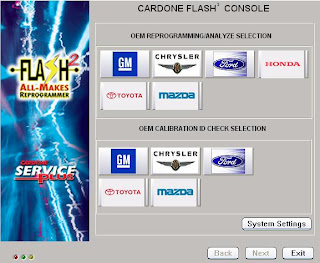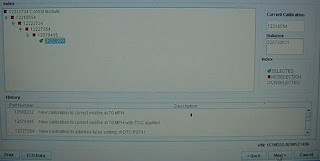Use this blog to share items of interest to those on the carfix_online mailing list. Note: Video and audio clips are not to be reproduced, duplicated, copied, for sale, trade, resell or exploit for any commercial purposes. If you like what you see here, why not Join our group at groups.io/g/carfixonline
Friday, April 30, 2010
Thump! Oh crap, another one. PDR can Fix it!
Thursday, April 29, 2010
Quickie: 002

The complaint is an MIL on. The first step to find what causes an MIL is to get the stored trouble code. This one is P0456. A small leak detected in the evaporative system.
Where would you start? You start with an inspection of the gas cap and check the gas cap seal for cracks. Underhood you should inspect the evap hoses for cracks, especially any rubber hoses that fasten to plastic or steel tubing. There, near the throttle body is a small leak in the rubber hose where it fastens to the plastic tube. Under car look for the same sort of cracks. Another hose was cracked near the canister.
It only takes some careful inspection.
Kenneth Hayes
deranger@ipa.net
Quickie: 001

Tuesday, April 27, 2010
GM Flashing 3

Now choose PCM, Normal and "Next". Turn off the key and replace the PCM. I turn the charger off at this time as well. I like to get the PCM up into an area where I have good access and that is possible here without too much trouble. These things are buried sometimes.
Loosen the hex head bolts in the center of each connector and you can remove the wire connectors from the PCM. There are weather seals at each connector and they tend to stay with the PCM so be sure you put them back on the connectors before fastening them to the new computer. Speaking of weather sealers... when I disconnected the wiring from the PCM I noticed a drop of water. You should always give things a closer look so:
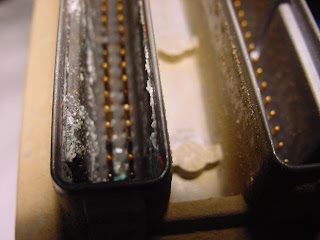
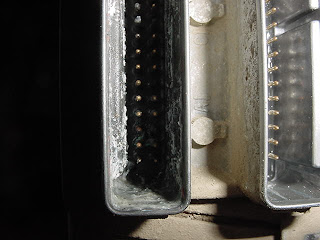
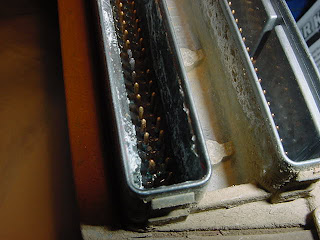 There is water standing in the area around the PCM pins and a lot of corrosion damage. Now I am not surprised the vin could not be retrieved. The fault causing me to replace the PCM was that it could not read the correct O2 sensor output for Bank1 Sensor1. I'm surprised now that it could do much of anything correctly. Now we'll want to clean the female terminals in the connectors very carefully before installing them on the replacement PCM. We don't want any of the corrosion to remain. We'll also need to figure out what allowed the water in and what we can do to prevent this happening again.
There is water standing in the area around the PCM pins and a lot of corrosion damage. Now I am not surprised the vin could not be retrieved. The fault causing me to replace the PCM was that it could not read the correct O2 sensor output for Bank1 Sensor1. I'm surprised now that it could do much of anything correctly. Now we'll want to clean the female terminals in the connectors very carefully before installing them on the replacement PCM. We don't want any of the corrosion to remain. We'll also need to figure out what allowed the water in and what we can do to prevent this happening again. Sunday, April 25, 2010
GM Flashing 2

 The 10 amp setting has about twice the a/c noise as the alternator output but this 2 amp setting keeps the battery up and is a very clean output. Does any of that matter? I'm not sure but it does work so I'm staying with it.
The 10 amp setting has about twice the a/c noise as the alternator output but this 2 amp setting keeps the battery up and is a very clean output. Does any of that matter? I'm not sure but it does work so I'm staying with it. 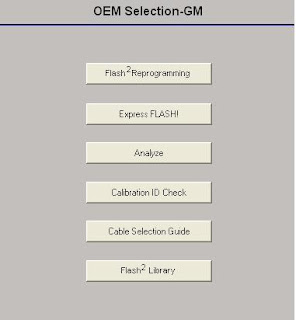 On the next screen there is a choice to do the flash on-car or off-car. If you have purchased the extra leads you can flash an ecm with no car involved. I use the off-car for the convenience of other shops. They can bring me the ecm they need flashed and keep the car in their own shop. As long as the ecm is the same part number I can even reprogram a used module to work on a different vehicle. It is very easily done with most GM vehicles. For my own non-professional customers I prefer to do a flash on-car. Sometimes you need to be able to access more than one module and sometimes other issues arise such as security relearns. I think of it like this, I used to repair and overhaul carburetors. Actually I still do but it isn't very often any more. When a customer brings in only the carb for repair they can't get a complete job. With the complete car I can see that the carburetor is properly removed, installed, make adjustments and address any issues the car may have that affect the carb operation such as a misfire or vacuum leak. An off-car ecm flash is similar to that, the job can need further work to be complete.
On the next screen there is a choice to do the flash on-car or off-car. If you have purchased the extra leads you can flash an ecm with no car involved. I use the off-car for the convenience of other shops. They can bring me the ecm they need flashed and keep the car in their own shop. As long as the ecm is the same part number I can even reprogram a used module to work on a different vehicle. It is very easily done with most GM vehicles. For my own non-professional customers I prefer to do a flash on-car. Sometimes you need to be able to access more than one module and sometimes other issues arise such as security relearns. I think of it like this, I used to repair and overhaul carburetors. Actually I still do but it isn't very often any more. When a customer brings in only the carb for repair they can't get a complete job. With the complete car I can see that the carburetor is properly removed, installed, make adjustments and address any issues the car may have that affect the carb operation such as a misfire or vacuum leak. An off-car ecm flash is similar to that, the job can need further work to be complete. 
If I disable the automatic headlamps and wait a couple of minutes I get a "pass" but the voltage is at the minimum allowed.
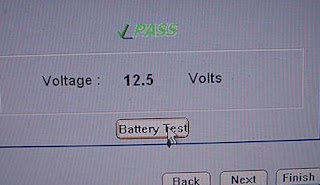
Now I could crank the charger up a notch but since it is a controversial issue anyway I chose to add a booster pack to the mix. With the charger on 2 amp, a booster pack connected and the auto headlamps disabled I have a 12.8 volt battery test result so we'll click "next". A few more important instructions to read through and then we'll click "next" again. Choose GM or Saturn. We'll choose GM. Choose cd/dvd or web link. We are using the web link. After clicking "next" the GM server screen will come up and you can enter your user name and password. Scroll to the bottom of the "terms and conditions", choose "accept" and click "continue". Click "service and programming information". Click "TIS2 Web Service Programming". I always get a message popup that says there is unread news. Click "ok". Choose Service Programming System on the left of the next screen. Another popup, whatever is a current news message. Click "ok". Now always read your instructions that come up on each screen, especially when you are new to the process. On this next screen click "start sps".
SPS is a java program so make sure you have a late version of java installed. If your version is too old it won't work. Sometimes it doesn't work anyway.
 I could dress this all up but it would be dishonest. The truth is that flashing can be very frustrating and is not for the faint of heart. Occasionally things go very smoothly, more often they do not. Now this could be a java error or a problem with my own computer. It could be a problem with the GM side of the application. "Details" is meaningless jargon to me so first a reboot is tried with no help. Next a system restore to a couple days earlier. That didn't work either. Uninstalling Java and then reinstalling Java did the trick.
I could dress this all up but it would be dishonest. The truth is that flashing can be very frustrating and is not for the faint of heart. Occasionally things go very smoothly, more often they do not. Now this could be a java error or a problem with my own computer. It could be a problem with the GM side of the application. "Details" is meaningless jargon to me so first a reboot is tried with no help. Next a system restore to a couple days earlier. That didn't work either. Uninstalling Java and then reinstalling Java did the trick.
What you see next is a visual of the reprogramming process. The update has been downloaded from the GM server to the pc and now the pc is loading the updated programming into the ECU through the J2534 Flash2 device. It is a very critical time. I had the pc lock up once during this process and destroy a PCM. I had to replace it. The programming had not proceeded far enough that the PCM would re-establish communication.
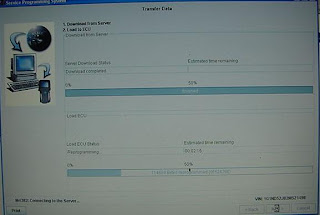
Once the programming is complete you'll see any specific instructions that may apply to the system. This one may need crankshaft variation relearned or set code P1336/P0315. If on restart I see this code then I will know to perform a crankshaft relearn.
We are done with the GM server and can cancel, returning to the Flash2 pc software to exit. The Flash2 software will ask us to leave the J2534 device connected for 30 seconds for a final burn of the new programming. Just follow the instructions. Now before exiting the software completely we can verify the new programming calibration using "analyze" mode.
 Notice the calibration is now 12588232 or the most current available at this time. We have verified the flash was successful. We aren't done yet. Let's turn off the charger, disconnect the booster pack, replace those automatic headlamp relays and see if the car starts. Eureka! Sometimes a security relearn has to be done before the car will start. This one started fine so we want to notice if the Service Engine light is off. Remember we were warned there may be a crankshaft relearn to be done. Not in this case. The light is off and we are finished. There that wasn't so bad. It always feels good when you are done. I hope this gave you a good idea of what is involved in a flash session and what can happen. Next we'll cover a GM flash using the Snapon J2534 device, Pass Thru Pro II if there is interest.
Notice the calibration is now 12588232 or the most current available at this time. We have verified the flash was successful. We aren't done yet. Let's turn off the charger, disconnect the booster pack, replace those automatic headlamp relays and see if the car starts. Eureka! Sometimes a security relearn has to be done before the car will start. This one started fine so we want to notice if the Service Engine light is off. Remember we were warned there may be a crankshaft relearn to be done. Not in this case. The light is off and we are finished. There that wasn't so bad. It always feels good when you are done. I hope this gave you a good idea of what is involved in a flash session and what can happen. Next we'll cover a GM flash using the Snapon J2534 device, Pass Thru Pro II if there is interest.
Kenneth Hayes
AKA Deranger
Friday, April 23, 2010
Preventative Maintenence-do you do it based on miles or hours or both?
GM Flashing

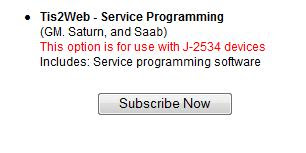 I should mention that no matter what brand of J2534 device you use you will need to use these steps to establish the GM TIS2 Web account and flash GM vehicles. After the Subscribe Now you'll be sent to the login page. If you have no account then choose "click here" and follow instructions to set up an account. Login and password are case-sensitive so be aware of that.
I should mention that no matter what brand of J2534 device you use you will need to use these steps to establish the GM TIS2 Web account and flash GM vehicles. After the Subscribe Now you'll be sent to the login page. If you have no account then choose "click here" and follow instructions to set up an account. Login and password are case-sensitive so be aware of that. Once the account is setup you'll get an email to verify and then can access your new account from the Login page. After the login you'll be directed to the "terms and conditions of use" page. If you scroll, at the bottom is a choice to accept and then to continue. Now that you have an account you'll need a subscription. If you accepted the use terms and clicked on continue you should be at a page that allows you to choose "Service Information" (GM may make changes to the site so this can only be a guide at best). Choose "Subscribe Now" for J2534 reprogramming, choose your subscription type and follow the instructions. You'll get a confirmation email. Once the subscription is current you are ready to use the Flash2 or other J2534 device.
Watch for part 2 in this series. We'll need to get the Flash2 up and running.
Kenneth Hayes
AKA Deranger
Friday, April 16, 2010
Alignments- What you need to know about them.
Friday, April 09, 2010
Hey Look! I found the Loose Nut!

BTW: Gonzo has joined our mailing list here on carfix_online a few weeks ago.
Friday, April 02, 2010
Thursday, April 01, 2010
Chrysler's new Transmission the "Turboencabulator"


